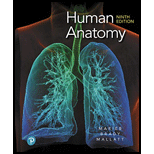
EBK HUMAN ANATOMY
9th Edition
ISBN: 9780135241752
Author: Marieb
Publisher: PEARSON CO
expand_more
expand_more
format_list_bulleted
Concept explainers
Question
Chapter 15, Problem 2CYU
Summary Introduction
To review:
The division of ANS (autonomic nervous system) that is activated upon actions and induces the pumping of heart and sweating.
Introduction:
The autonomic nervous system refers to a system of motor neurons that innervates the cardiac muscle, glands, and smooth muscles of the body. This system is involved in the regulation of various visceral functions, for instance, urination, blood pressure, heart rate, and digestion. The autonomic nervous system is classified into sympathetic and parasympathetic divisions.
Expert Solution & Answer
Want to see the full answer?
Check out a sample textbook solution
Students have asked these similar questions
What is the structure and function of Eukaryotic cells, including their organelles? How are Eukaryotic cells different than Prokaryotic cells, in terms of evolution which form of the cell might have came first? How do Eukaryotic cells become malignant (cancerous)?
What are the roles of DNA and proteins inside of the cell? What are the building blocks or molecular components of the DNA and proteins? How are proteins produced within the cell? What connection is there between DNA, proteins, and the cell cycle? What is the relationship between DNA, proteins, and Cancer?
Why cells go through various types of cell division and how eukaryotic cells control cell growth through the cell cycle control system?
Chapter 15 Solutions
EBK HUMAN ANATOMY
Ch. 15 - Which fibers in the motor division of the PNS are...Ch. 15 - Prob. 2CYUCh. 15 - Where are the sympathetic ganglia located? Where...Ch. 15 - Are visceral sensory fibers considered part of the...Ch. 15 - Which spinal nerves carry parasympathetic...Ch. 15 - Prob. 6CYUCh. 15 - Prob. 7CYUCh. 15 - Why are white rami communicantes located only on...Ch. 15 - What is the general effect of sympathetic...Ch. 15 - Which types of autonomic fibers (preganglionic,...
Ch. 15 - Prob. 11CYUCh. 15 - Prob. 12CYUCh. 15 - Which region of the CNS is the main control center...Ch. 15 - Which embryonic tissue forms the postganglionic...Ch. 15 - Which division of the ANS is deficient in...Ch. 15 - Prob. 1RQCh. 15 - For each of the following terms or phrases, write...Ch. 15 - The thoracic splanchnic nerves contain which kind...Ch. 15 - The collateral ganglia contain which kind of cell...Ch. 15 - Preganglionic sympathetic neurons develop from (a)...Ch. 15 - Prob. 6RQCh. 15 - The white rami communicantes contain what kind of...Ch. 15 - Collateral sympathetic ganglia are involved. with...Ch. 15 - Is the visceral sensory nervous system part of the...Ch. 15 - (a) Describe the anatomical relationship of the...Ch. 15 - What effect does sympathetic activation have on...Ch. 15 - Which of the effects listed in question 11 would...Ch. 15 - A friend asks you how the parasympathetic...Ch. 15 - What manifestations of decreased ANS efficiency...Ch. 15 - The students in anatomy class were having...Ch. 15 - Describe the sympathetic pathways to the (a)...Ch. 15 - Prob. 17RQCh. 15 - Prob. 18RQCh. 15 - Prob. 19RQCh. 15 - How do the somatic motor and visceral motor (ANS)...Ch. 15 - A 1-year-old infant has a swollen abdomen and is...Ch. 15 - Prob. 2CRCAQCh. 15 - Prob. 3CRCAQCh. 15 - Prob. 4CRCAQCh. 15 - Prob. 5CRCAQCh. 15 - Prob. 6CRCAQCh. 15 - Prob. 7CRCAQCh. 15 - Prob. 8CRCAQ
Knowledge Booster
Learn more about
Need a deep-dive on the concept behind this application? Look no further. Learn more about this topic, biology and related others by exploring similar questions and additional content below.Similar questions
- In one paragraph show how atoms and they're structure are related to the structure of dna and proteins. Talk about what atoms are. what they're made of, why chemical bonding is important to DNA?arrow_forwardWhat are the structure and properties of atoms and chemical bonds (especially how they relate to DNA and proteins).arrow_forwardThe Sentinel Cell: Nature’s Answer to Cancer?arrow_forward
- Molecular Biology Question You are working to characterize a novel protein in mice. Analysis shows that high levels of the primary transcript that codes for this protein are found in tissue from the brain, muscle, liver, and pancreas. However, an antibody that recognizes the C-terminal portion of the protein indicates that the protein is present in brain, muscle, and liver, but not in the pancreas. What is the most likely explanation for this result?arrow_forwardMolecular Biology Explain/discuss how “slow stop” and “quick/fast stop” mutants wereused to identify different protein involved in DNA replication in E. coli.arrow_forwardMolecular Biology Question A gene that codes for a protein was removed from a eukaryotic cell and inserted into a prokaryotic cell. Although the gene was successfully transcribed and translated, it produced a different protein than it produced in the eukaryotic cell. What is the most likely explanation?arrow_forward
- Molecular Biology LIST three characteristics of origins of replicationarrow_forwardMolecular Biology Question Please help. Thank you For E coli DNA polymerase III, give the structure and function of the b-clamp sub-complex. Describe how the structure of this sub-complex is important for it’s function.arrow_forwardMolecular Biology LIST three characteristics of DNA Polymerasesarrow_forward
arrow_back_ios
SEE MORE QUESTIONS
arrow_forward_ios
Recommended textbooks for you
 Biology: The Dynamic Science (MindTap Course List)BiologyISBN:9781305389892Author:Peter J. Russell, Paul E. Hertz, Beverly McMillanPublisher:Cengage Learning
Biology: The Dynamic Science (MindTap Course List)BiologyISBN:9781305389892Author:Peter J. Russell, Paul E. Hertz, Beverly McMillanPublisher:Cengage Learning Human Physiology: From Cells to Systems (MindTap ...BiologyISBN:9781285866932Author:Lauralee SherwoodPublisher:Cengage Learning
Human Physiology: From Cells to Systems (MindTap ...BiologyISBN:9781285866932Author:Lauralee SherwoodPublisher:Cengage Learning- Basic Clinical Lab Competencies for Respiratory C...NursingISBN:9781285244662Author:WhitePublisher:Cengage


Biology: The Dynamic Science (MindTap Course List)
Biology
ISBN:9781305389892
Author:Peter J. Russell, Paul E. Hertz, Beverly McMillan
Publisher:Cengage Learning

Human Physiology: From Cells to Systems (MindTap ...
Biology
ISBN:9781285866932
Author:Lauralee Sherwood
Publisher:Cengage Learning



Basic Clinical Lab Competencies for Respiratory C...
Nursing
ISBN:9781285244662
Author:White
Publisher:Cengage
